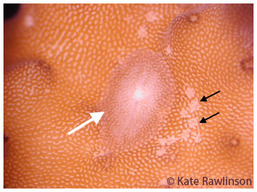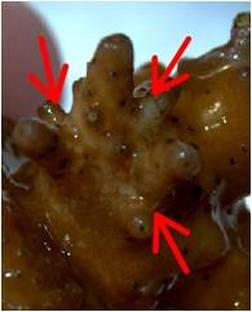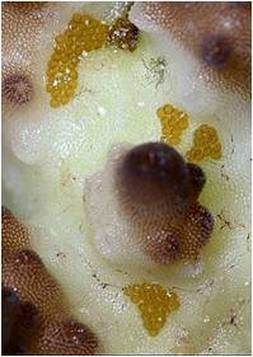Acropora Eating Flatworms
Background:

Adult (white arrow) with feeding scars (black arrows)
The Acropora-eating flatworm (AEF or AEFW) is a common predator of aquarium Acropora species.They consume coral tissue and are extremely well-camouflaged. On first glance, the only visible sign of their presence is feeding scars, which expose the coral skeleton. Feeding lesions may be misdiagnosed as other syndromes (potentially classed in the WS group), and so the impact of this predator in the wild is not fully appreciated. The AEFW has just been discovered in the wild, click here http://dx.plos.org/10.1371/journal.pone.0042240 to read the article. This discovery will allow Dr Rawlinson and her collaborators to determine the impact of this corallivore in the wild and identify its natural predators as possible biological controls in aquaria.
Causes:

Although a problematic Acropora predator in aquaria for over 10 years, very little was known about the AEFW, it's biology or taxonomic affinity until last year when it was named Amakusaplana acroporae (a polyclad worm belonging to the phylum Platyhelminthes) and information on its life history was described (Rawlinson et al. 2011). As this parasite is now widely distributed in the marine aquarium industry it is easily transferred between aquaria by the exchange of cultivated colonies. Great care should be taken when receiving Acropora colonies from another collection to quarantine them before introducing them to aquaria with existing Acropora spp. The quarantine period should involve close observations to look specifically for this small flatworm (adult size: ~ 1cm), it's feeding scars and egg batches which are laid on the bare coral skeleton.
Management or Mitigation:

Eggs batches on coral skeleton (photo by J. Weatherson)
For the treatment of flatworm infections, including the AEFW, Salifert’s Flatworm Exit, levamisole hydrochloride, freshwater dips (15 ppt for 3 m max) and iodine-based dips like Lugols iodine, Fluke-Tabs (Aquarium Products), and Trichlorfon (Dylox 80, Bayer A.G.) have all been reported for treatment of infected corals (Carl 2008; Nosratpour 2008). However, it is important to note that smaller polyp species such as the Acroporids can rarely tolerate the use of freshwater dips and often mortality occurs soon after treatment.
FlatwormStop is a new treatment from Zeovit which allows direct dosing of a full stocked reef aquariums. FlatwormStop is safe for all fish and invertebrates and it works to eradicate Acro Eating Flatworms by stimulating the immune response of Acropora corals.
Read more: http://reefbuilders.com/2012/01/18/zeovit-flatwormstop/#ixzz20pnjju1D
Below is one Hobbyist Procedure for eradication of these pests.
1. Remove all Acropora corals from rocks including encrusted ones and scrape off encrusted left over coral parts on the rocks. Inspect each coral with a flashlight for 2 minutes outside of tank and water (a bit of air drying allows eggs to be easier to identify) and scrape any off eggs. Might be beneficial to cut the base off certain heavily infested corals and through out a others which have to many eggs.
2. Dip in diluted Revive solution (according to instructions) for 8-10 minutes for hardy Acroporas but 5 minutes for deep water Acroporas and other sensitive corals. Swirl corals initially in Revive solution then blast them with a turkey baster 5-10 times while dipping.
Be careful with deep water Acropora corals and others. Pearlberry, Ice Fire, and Hawkins Eechidna corals are especially sensitive as you can blast the skin off of them if you are too harsh.
3. Swirl and let sit in fresh saltwater after Revive dip for 10 minutes. Blast with turkey baster 3-4 times every few minutes. Return to tank but on sand bed.
4. Repeat weekly for 2 additional weeks.
5. Glue corals to small rock bases and reattach to live rock. Now check periodically for re infestation e.g. bitemarks and AEFW’s that may come off by blasting, etc. Use common sense.
6. Add a natural predator or two; e.g. Yellow Wrasse, scientific name Halichoeres chrysus, to form a biological AEFW control team with others such as the Six Line Wrasse. These guys like to eat a variety of small pests from corals.
Read more at http://redseamaxreef.com/how-to-control-acropora-eating-flatworms-aefw
FlatwormStop is a new treatment from Zeovit which allows direct dosing of a full stocked reef aquariums. FlatwormStop is safe for all fish and invertebrates and it works to eradicate Acro Eating Flatworms by stimulating the immune response of Acropora corals.
Read more: http://reefbuilders.com/2012/01/18/zeovit-flatwormstop/#ixzz20pnjju1D
Below is one Hobbyist Procedure for eradication of these pests.
1. Remove all Acropora corals from rocks including encrusted ones and scrape off encrusted left over coral parts on the rocks. Inspect each coral with a flashlight for 2 minutes outside of tank and water (a bit of air drying allows eggs to be easier to identify) and scrape any off eggs. Might be beneficial to cut the base off certain heavily infested corals and through out a others which have to many eggs.
2. Dip in diluted Revive solution (according to instructions) for 8-10 minutes for hardy Acroporas but 5 minutes for deep water Acroporas and other sensitive corals. Swirl corals initially in Revive solution then blast them with a turkey baster 5-10 times while dipping.
Be careful with deep water Acropora corals and others. Pearlberry, Ice Fire, and Hawkins Eechidna corals are especially sensitive as you can blast the skin off of them if you are too harsh.
3. Swirl and let sit in fresh saltwater after Revive dip for 10 minutes. Blast with turkey baster 3-4 times every few minutes. Return to tank but on sand bed.
4. Repeat weekly for 2 additional weeks.
5. Glue corals to small rock bases and reattach to live rock. Now check periodically for re infestation e.g. bitemarks and AEFW’s that may come off by blasting, etc. Use common sense.
6. Add a natural predator or two; e.g. Yellow Wrasse, scientific name Halichoeres chrysus, to form a biological AEFW control team with others such as the Six Line Wrasse. These guys like to eat a variety of small pests from corals.
Read more at http://redseamaxreef.com/how-to-control-acropora-eating-flatworms-aefw
External Links:

Photo of live Amakusaplana acroporae hatchling
http://reefkeeping.com/issues/2007-09/mc/index.php
http://reefbuilders.com/2011/04/15/acropora-eating-flatworms/
Please e-mail Kate Rawlinson ([email protected]) for more information on the biology and life history of the AEFW and for a reprint of the paper "Taxonomy and life history of the Acropora-eating flatworm, Amakusaplana acroporae nov. sp. (Polycladida: Prosthiostomidae) Coral Reefs 30:693–705. Kate would be very interested to hear of AEFW problems you may have and is always looking for more specimens to analyse to help understand these coral predators.
http://reefbuilders.com/2011/04/15/acropora-eating-flatworms/
Please e-mail Kate Rawlinson ([email protected]) for more information on the biology and life history of the AEFW and for a reprint of the paper "Taxonomy and life history of the Acropora-eating flatworm, Amakusaplana acroporae nov. sp. (Polycladida: Prosthiostomidae) Coral Reefs 30:693–705. Kate would be very interested to hear of AEFW problems you may have and is always looking for more specimens to analyse to help understand these coral predators.
